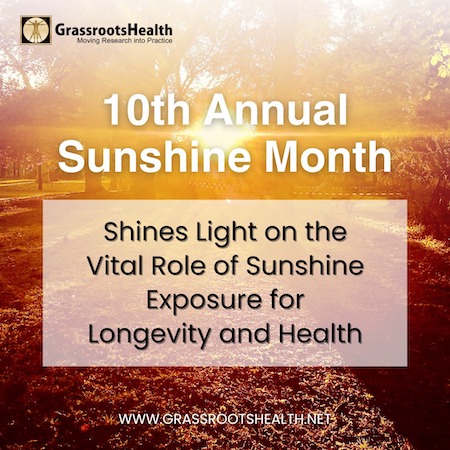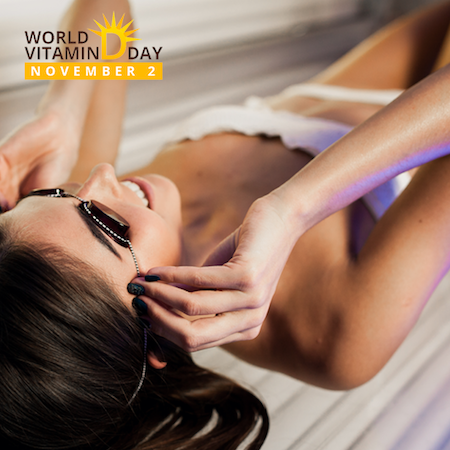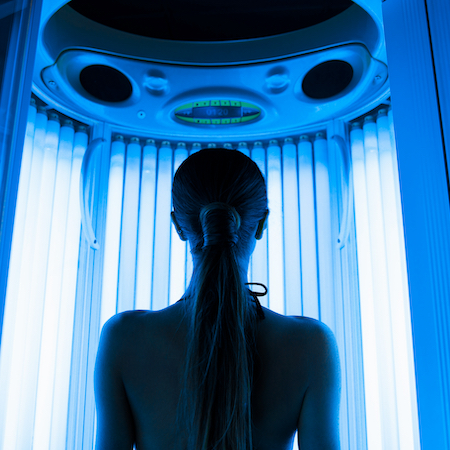Two different research groups conclude the US RDA is off by an order of magnitude
GrassrootsHealth scientists and staff have published a research letter, citing the D*action data, calling for the Institute of Medicine (IOM) to increase its current vitamin D recommended dietary allowance (RDA) from 600 IU/day to 7,000 IU/day from all sources. This includes an estimated 3875 IU/day in supplementation and approximately 3000 IU/day from other sources (primarily food and sun exposure).
What does this mean for people trying to achieve their target vitamin D level through UVB exposure?
Sunlight is a well-known source of vitamin D, but other sources of UVB light, such as indoor tanning lamps, can also effectively raise vitamin D levels. In addition to sun exposure habits, we also ask our D*action participants about their habits relating to indoor tanning. Participants are asked how often they have used indoor tanning equipment in the prior 6 months. The chart below summarizes the vitamin D levels among participants who reported not using vitamin D supplements according to indoor tanning frequency.
The average vitamin D level was 41 ng/ml (102 nmol/L) for those who regularly used indoor tanning, 34 ng/ml (85 nmol/L) for infrequent users, and 28 ng/ml (70 nmol/L) for non-users. More than half of regular users (55%) had a vitamin D level at or above 40 ng/ml (100 nmol/L) compared to 31% of infrequent users and 17% of non-users. Only 3% of regular users had vitamin D levels less than 20 ng/ml (50 nmol/L) compared to 5% of infrequent users and 18% of non-users.These results show that indoor tanning could be used to achieve a vitamin D level at or above 40 ng/ml (100 nmol/L), but that frequency is important.
These results show that indoor tanning could be used to achieve a vitamin D level at or above 40 ng/ml (100 nmol/L), but that frequency is important.
As with sun exposure, it is also important to be mindful of duration with indoor tanning and not burn.
Back to the question of how long….
If you are trying to get vitamin D from the sun, a phone app called dminder allows you to optimize UVB and sun exposure time based on your location, skin type, and time of day, and gives an estimate of how much vitamin D has been produced. The app also gives warnings of any risk to your skin getting burned so that you have a better idea of when to get out of the sun or cover up. dminder is very conservative because it uses estimates from the environmental protection agency (EPA). And, an added bonus – you can link your dminder data to your GrassrootsHealth.net participant account!
The lighter your skin and the more you have stayed indoors- the more important it is to be cautious and slow, allowing your skin to adjust to sun exposure gradually, and always being careful not to burn.
Are you using UVB as a source of vitamin D?
Is UVB exposure, whether from indoor lamps or from the sun, helping to improve your vitamin D level? Make sure you know your vitamin D level, and see if you are in the target range of 40-60 ng/ml (100-150 nmol/L). Find out your levels today!
Make sure you track your results before and after, about every 6 months!
How can I track my UVB exposure and my vitamin D levels?
To help you track your indoor UVB and sun exposure along with vitamin D levels, GrassrootsHealth has created an online tracking system called myData-myAnswers. You can also track your dietary intake and supplement use to see how both sun exposure and vitamin D from food and supplements impact your vitamin D levels and your health.
Article originally published by tanning-source-vitamin-d


